No edit summary Tag: Visual edit |
No edit summary Tag: Visual edit |
||
| Line 31: | Line 31: | ||
== '''Debunking "The Curse":''' == |
== '''Debunking "The Curse":''' == |
||
In 1921, a '''fictional''' outdoor play written in the early 20th century was held in Point Pleasant WV. The play was based on the town's history with dramatized and fictionalized elements. In the play, Cornstalk says "I came to the fort as your friend and you murdered me. ... You have murdered by my side, my young son. ... For this, may the curse of the Great Spirit rest upon this land. May it be blighted by nature. May it even be blighted in its hopes. May the strength of its peoples be paralyzed by the stain of our blood." No historical source mentions any such utterance by Cornstalk. The story of this "two hundred year curse" was then passed down from generation to generation through oral story-telling despite it being information from a fictionalized play. The story was finally debunked when a transcript of the play was discovered. |
In 1921, a '''fictional''' outdoor play written in the early 20th century was held in Point Pleasant WV. The play was based on the town's history with dramatized and fictionalized elements. In the play, Cornstalk says "I came to the fort as your friend and you murdered me. ... You have murdered by my side, my young son. ... For this, may the curse of the Great Spirit rest upon this land. May it be blighted by nature. May it even be blighted in its hopes. May the strength of its peoples be paralyzed by the stain of our blood." No historical source mentions any such utterance by Cornstalk. The story of this "two hundred year curse" was then passed down from generation to generation through oral story-telling despite it being information from a fictionalized play. The story was finally debunked when a transcript of the play was discovered. |
||
| + | |||
In the 2012 book Monsters of West Virginia, [https://themothman.fandom.com/wiki/Rosemary_Ellen_Guiley Rosemary Ellen Guiley] explains how the story was "recently ... debunked as fiction". She added: "A man taken by surprise and shot multiple times at point-blank range and who was not killed instantly probably would not be able to muster much consciousness for anything in his final moments, let alone [such a] dramatic pronouncement". |
In the 2012 book Monsters of West Virginia, [https://themothman.fandom.com/wiki/Rosemary_Ellen_Guiley Rosemary Ellen Guiley] explains how the story was "recently ... debunked as fiction". She added: "A man taken by surprise and shot multiple times at point-blank range and who was not killed instantly probably would not be able to muster much consciousness for anything in his final moments, let alone [such a] dramatic pronouncement". |
||
| Line 36: | Line 37: | ||
In 2018, local historian and re-enactor Craig Hesson was interviewed by WOWKTV about The Battle of Point Pleasant. When asked about the alleged curse he explained “It was a part of play done in 1921 ... they needed to make it more exciting, and I think they did ... but the real history is much more interesting.” |
In 2018, local historian and re-enactor Craig Hesson was interviewed by WOWKTV about The Battle of Point Pleasant. When asked about the alleged curse he explained “It was a part of play done in 1921 ... they needed to make it more exciting, and I think they did ... but the real history is much more interesting.” |
||
| + | |||
| − | + | '''Sources:''' |
|
Monsters of West Virginia by Rosemary Ellen Guiley (2012), Page 45 |
Monsters of West Virginia by Rosemary Ellen Guiley (2012), Page 45 |
||
| Line 42: | Line 44: | ||
The Mothman of Point Pleasant Documentary by Small Town Monsters (2017) |
The Mothman of Point Pleasant Documentary by Small Town Monsters (2017) |
||
| − | https://www.wowktv.com/news/special-reports/the-hidden-history-of-the-battle-of-point-pleasant-part-3/ |
+ | [https://www.wowktv.com/news/special-reports/the-hidden-history-of-the-battle-of-point-pleasant-part-3/ https://www.wowktv.com/news/special-reports/the-hidden-history-of-the-] |
| + | [https://www.wowktv.com/news/special-reports/the-hidden-history-of-the-battle-of-point-pleasant-part-3/ battle-of-point-pleasant-part-3/] (May 2018) |
||
| − | https://web.archive.org/web/20200209093444/https://www.wowktv.com/news/special-reports/the-hidden-history-of-the-battle-of-point-pleasant-part-3/ |
+ | [https://web.archive.org/web/20200209093444/https://www.wowktv.com/news/special-reports/the-hidden-history-of-the-battle-of-point-pleasant-part-3/ https://web.archive.org/web/20200209093444/https://www.wowktv.com/news/] |
| + | [https://web.archive.org/web/20200209093444/https://www.wowktv.com/news/special-reports/the-hidden-history-of-the-battle-of-point-pleasant-part-3/ special-reports/the-hidden-history-of-the-battle-of-point-pleasant-part-3/] |
||
== "'''Fighting Chief Cornstalk's Remains Laid to Rest Again"''' == |
== "'''Fighting Chief Cornstalk's Remains Laid to Rest Again"''' == |
||
Revision as of 10:16, 9 February 2020
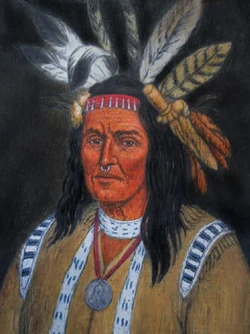
Cornstalk
History
"Fighting" Chief Cornstalk (1720 - 1777) was a prominent leader of the Shawnee nation just prior to the American Revolution from 1775 to 1783. His name, Hokoleskwa, translates loosely into "stalk of corn" in English, and is spelled Colesqua in some accounts. He was also known as Keigh-tugh-qua and Wynepuechsika.
Cornstalk opposed European settlement west of the Ohio River in his youth, but he later became an advocate for peace after the Battle of Point Pleasant in 1774. His murder by American militiamen at Fort Randolph during a diplomatic visit in November of 1777 outraged both Native American and Virginians.
Artist Bob Roach built a statue of Cornstalk which is located along the Ohio River Floodwall in the town of Point Pleasant, West Virginia alongside other historical figures associated with the area.
Early Years
Historians believe he may have been born in present-day Pennsylvania, and with his sister, Nonhelema, moved to the Ohio Country, near present day Chillicothe, when the Shawnee fell back before expanding white settlement. Stories tell of Cornstalk's participation in the "French and Indian War" from 1754 to1763, though these are probably apocryphal. His alleged participation in Pontiac's Rebellion from 1763 to 1766 is also unverified, though he did take part in the peace negotiations.
Dunmore's War
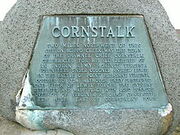
Cornstalk monument located at Logan Elm State Memorial in Pickaway County, Ohio.
Cornstalk played a central role in Dunmore's War of 1774. After the 1768 Treaty of Fort Stanwix, settlers and land speculators moved into the lands south of the Ohio River in present-day Kentucky. Although the Iroquois had agreed to cede the land, the Shawnee and others had not been present at the Fort Stanwix negotiations. They still claimed Kentucky as their hunting grounds. Clashes soon took place over this. Cornstalk tried unsuccessfully to prevent escalation of the hostilities.
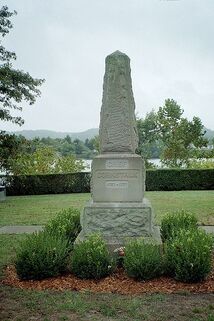
Cornstalk's gravesite in Point Pleasant, West Virginia.
Attempting to block a Virginian invasion of the Ohio country, Cornstalk led a force of Shawnee and Mingo warriors at the Battle of Point Pleasant. His attack, although ferociously made, was beaten back by the Virginians. Cornstalk retreated and would reluctantly accept the Ohio River as the boundary of Shawnee lands in the Treaty of Camp Charlotte.
Cornstalk's commanding presence often impressed American colonials. A Virginia officer, Col. Benjamin Wilson, wrote of Cornstalk's speech to Lord Dunmore at Camp Charlotte in 1774: "I have heard the first orators in Virginia, Patrick Henry and Richard Henry Lee, but never have I heard one whose powers of delivery surpassed those of Cornstalk on that occasion."
American Revolution
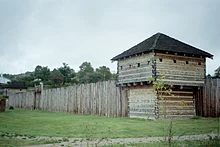
With the American Revolution began, Cornstalk worked to keep his people neutral. He represented the Shawnee at treaty councils at Fort Pitt in 1775 and 1776, the first native treaties ever negotiated by the United States. Many Shawnees nevertheless hoped to use British aid to reclaim their lands lost to the settlers. By the winter of 1776, the Shawnee were effectively divided into a neutral faction led by Cornstalk, and militant bands led by men such as Blue Jacket.
In the fall of 1777, Cornstalk made a diplomatic visit to Fort Randolph, an American fort at present-day Point Pleasant, seeking as always to maintain his faction's neutrality. Cornstalk was detained by the fort commander, who had decided on his own initiative to take hostage any Shawnees who fell into his hands. When, on November 10th, an American militiaman from the fort was killed nearby by unknown native, angry soldiers brutally executed Cornstalk, his son Elinipsico, and two other Shawnees.
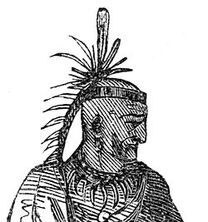
An 1872 drawing of Cornstalk from "Frost's Pictorial History of Indian Wars and Captivities"
American political and military leaders were alarmed by the murder of Cornstalk; they believed he was their only hope of securing Shawnee neutrality. At the insistence of Patrick Henry, then governor of Virginia, Cornstalk's killers, whom Henry called "vile assassins", were eventually brought to trial, but since their fellow soldiers would not testify against them, all were acquitted.
In 1840 Cornstalk's grave was rediscovered and his remains were moved to the Mason County Courthouse grounds. In 1954 the courthouse was torn down and he was reburied in Point Pleasant's national park Tu-Endie-Wei Park at the junction of Ohio and Kanawha Rivers.
Source: https://en.wikipedia.org/wiki/Cornstalk
Debunking "The Curse":
In 1921, a fictional outdoor play written in the early 20th century was held in Point Pleasant WV. The play was based on the town's history with dramatized and fictionalized elements. In the play, Cornstalk says "I came to the fort as your friend and you murdered me. ... You have murdered by my side, my young son. ... For this, may the curse of the Great Spirit rest upon this land. May it be blighted by nature. May it even be blighted in its hopes. May the strength of its peoples be paralyzed by the stain of our blood." No historical source mentions any such utterance by Cornstalk. The story of this "two hundred year curse" was then passed down from generation to generation through oral story-telling despite it being information from a fictionalized play. The story was finally debunked when a transcript of the play was discovered.
In the 2012 book Monsters of West Virginia, Rosemary Ellen Guiley explains how the story was "recently ... debunked as fiction". She added: "A man taken by surprise and shot multiple times at point-blank range and who was not killed instantly probably would not be able to muster much consciousness for anything in his final moments, let alone [such a] dramatic pronouncement".
In 2017, the Small Town Monsters documentary film "The Mothman of Point Pleasant" reaffirms that that story was fiction derived from an outdoor play. In the film, Dennis Bellamy of the Mason County Visitors Bureau and Point Pleasant resident Lyn-Fawn Cornwall-Robinson tell of how the transcript for the play was discovered and how the play came to be believed.
In 2018, local historian and re-enactor Craig Hesson was interviewed by WOWKTV about The Battle of Point Pleasant. When asked about the alleged curse he explained “It was a part of play done in 1921 ... they needed to make it more exciting, and I think they did ... but the real history is much more interesting.”
Sources: Monsters of West Virginia by Rosemary Ellen Guiley (2012), Page 45 The Mothman of Point Pleasant Documentary by Small Town Monsters (2017) https://www.wowktv.com/news/special-reports/the-hidden-history-of-the- battle-of-point-pleasant-part-3/ (May 2018) https://web.archive.org/web/20200209093444/https://www.wowktv.com/news/ special-reports/the-hidden-history-of-the-battle-of-point-pleasant-part-3/
"Fighting Chief Cornstalk's Remains Laid to Rest Again"
Full Story from Charleston Gazette Newspaper, September 21st 1954
"The last page of a sad chapter of American history was written at this Ohio River community today [September 21st 1954]. Chief Cornstalk, the Shawnee Indian leader who was taken hostage and murdered by white men to whom he had come to talk peace, was given a final resting place in a small park near the field of his most famous battle. His oft-moved grave now lies beside those of Colonial soldiers killed in that struggle the battle of Pt. Pleasant, Oct. 10, 1774 and Frontier Heroine Ann Bailey. In a lengthy ceremony at noon today, Cornstalk's last remains, three teeth and 15 bone fragments, were sealed in an aluminum box in the center of a four-ton stone monument bearing the simple inscription: 'Cornstalk.'
The monument and remains had been removed from the grounds of the old Mason County courthouse, which is being torn down to make way for a new court building. It was at least the third time the chieftain's body had been interred. After his death In 1777, he was buried near Fort Randolph the Colonial outpost at which he had been killed. Then in 1840, street- builders here unearthed his grave, and the remains were moved to the courthouse grounds, This year [1954], with the decision to raze Mason County's old courthouse and erect a new $700,000 structure in its place, it was decided to move the grave to historical Tu-Endie-Wei Park at the junction of Ohio and Kanawha Rivers. Amateur archaeologists began digging last Saturday morning, and after 10 hours of fruitless labor, it was feared that the chief's remains might not be found.
But early Sunday, persistent diggers came upon rust stains from the metal box in which Cornstalk had been reburied. In loose earth, they found the teeth and bone fragments which were decided to be 'undoubtedly those of Cornstalk.' The reburial today was directed by members of the Pt. Pleasant chapter of the Daughters of the American Revolution. The story of Cornstalk's seizure and murder is one of the dark spots in American history.
Born about 1735 in what is now Ohio, the future chieftain was named 'Kei.gh-tugh-qua,' meaning 'maize plant' hence the English name 'Cornstalk.' Little is known of his early life, but by 1763 he had become a Shawnee tribal chieftain and led war parties against several white settlements. In 1764, soldiers raided his tribal town and took him captive. He was carried to Fort Pitt as a hostage, but escaped the following year. In the following years, he became Sachem of all Shawnee tribes and finally king of the northern confederacy of Indian tribes, composed of the Shawnees, Delawares, Mingoes, Wyandottes and Cayugas.
On Oct. 10, 1774, he led 1,100 of his braves against an equal number of Colonial troops at Pt. Pleasant and after a violent battle, was defeated. Following his defeat, Cornstalk pursued a peace policy and forbade his braves to molest whites. But in 1777, with the American Revolution at its height, he returned to Pt. Pleasant with two companions to warn settlers that the British were trying to incite his tribesmen to attack them.
Fearing an attack, Colonial soldiers seized Cornstalk and his companions and imprisoned them in Fort Randolph as hostages. A month later, Cornstalk's son, Ellinipsico, came to the fort to see his father. During his visit, a soldier walking near the fort was killed by an Indian and other soldiers rushed to Cornstalk's quarters to kill him In revenge. Cornstalk, who is described by historians as a handsome, intelligent, and highly honorable man, stood calmly in the doorway to his room and faced his slayers. He was felled by nearly a dozen rifle shots. The soldiers then entered the room and killed Cornstalk's son and two companions. The murder of their chieftain turned the Shawnees from a neutral people into the most implacable warriors, who raided Virginia settlements for 20 years after the incident."